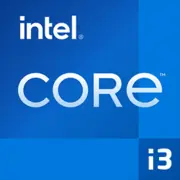Intel Core i3-1315U

Intel Core i3-1315U: A Balance of Energy and Performance for Mobile Tasks
March 2025
Introduction
Modern laptops require a compromise between power and battery life. The Intel Core i3-1315U processor, introduced in 2023, remains relevant in the budget segment even two years later. Let’s explore who this chip is suitable for, how it handles tasks, and what nuances to consider when choosing a device.
Architecture and Manufacturing Process
Raptor Lake: A Hybrid Approach
The Core i3-1315U is based on Raptor Lake architecture (Intel 7 process, 10 nm Enhanced SuperFin). It features a hybrid system with two types of cores:
- 2 Performance-cores (P-cores) — High-performance cores with Hyper-Threading support (4 threads), a base frequency of 1.2 GHz, and Turbo Boost up to 4.3 GHz.
- 4 Efficient-cores (E-cores) — Energy-efficient cores without Hyper-Threading (4 threads), operating at 0.9–3.3 GHz.
Cache and Graphics
- 10 MB L3 cache accelerates multithreaded operations.
- Integrated graphics Intel UHD Graphics (13th Gen) with 64 Execution Units (EUs), a frequency of up to 1.1 GHz. Supports 4K@60Hz, AV1 decoding, and HDMI 2.1.
Architecture Features
- Intel Thread Director technology optimizes task distribution between P- and E-cores.
- Support for DDR5/LPDDR5 and PCIe 4.0 (up to 8 lanes).
Power Consumption and TDP
15W TDP: A Balance Between Power and Battery Life
- The nominal thermal design power (TDP) of 15W allows the processor to be installed in thin ultraportables and devices with passive cooling.
- In turbo mode, consumption briefly reaches 55W, but a mid-level cooling system handles such spikes.
Energy-Saving Technologies
- Intel Dynamic Tuning 3.0 — Automatically adjusts voltage and frequencies based on workload.
- Adaptix — Tools for fine-tuning the balance between performance and battery life.
Performance in Real Tasks
Office Work
- Applications like Microsoft Office, browsers with 10+ tabs, Zoom conferences — the processor operates without delays. For instance, rendering a PowerPoint presentation with 3D elements takes 2–3 seconds.
Multimedia
- Converting a 30-minute 1080p video in HandBrake: ~22 minutes (compared to 18 minutes for the Ryzen 5 7530U).
- Streaming 4K video on Netflix or YouTube — the load on the iGPU does not exceed 60%, thanks to hardware AV1 decoding.
Gaming
- Light projects: CS2 runs at 40–50 FPS on low settings (720p), Genshin Impact achieves 25–30 FPS.
- Turbo mode supports a stable GPU frequency for up to 15 minutes, after which throttling begins due to overheating in compact cases.
Turbo Boost Mode
- In the Cinebench R23 benchmark: 5617 points (multithreaded) compared to 4800 points for the i3-1215U. However, under load, temperatures reach 95°C, typical for ultrabooks.
Usage Scenarios
Target Audience:
- Students and office workers — document work, web surfing, online learning.
- Portability-focused users — laptops weighing up to 1.3 kg (e.g., Acer Swift 3 2025).
- Secondary device — for travel or work in cafes.
Not Suitable For:
- Gamers (except for cloud gaming).
- Video editors and 3D designers.
Battery Life
Battery Runtime
- In devices with a 50–60 Wh battery (e.g., Lenovo IdeaPad 5) — up to 10 hours under mixed use (brightness 150 nits, Wi-Fi).
- With active use (Chrome + YouTube) — 6–7 hours.
Power Consumption Optimization
- The "Battery Saver" mode in Windows 12 reduces E-core frequency to 0.7 GHz, extending battery life by 15–20%.
- Intel Smart Cache reduces accesses to RAM, saving up to 3–5% energy.
Comparison with Competitors
AMD Ryzen 5 7530U (Zen 3, 6 cores/12 threads)
- Pros: Higher performance in multithreaded tasks (Cinebench R23: 6200 points), faster Radeon Graphics by 20%.
- Cons: Battery life is 1–2 hours shorter, laptop prices start at $700.
Apple M2 (8 cores, 10-core GPU)
- The MacBook Air with M2 is more expensive ($999) but offers 15+ hours of battery life and instant response in video editing. However, compatibility with Windows software is limited.
Intel Core i5-1335U
- $100–150 more expensive: 10 cores (2P+8E), higher performance in rendering. However, the price premium is not always justified for office use.
Pros and Cons of Core i3-1315U
Strengths:
- Laptop prices starting at $500.
- Support for Wi-Fi 6E and Thunderbolt 4.
- Cool and quiet even under load.
Weaknesses:
- Only 8 threads (compared to 12 for Ryzen 5).
- Graphics not suitable for gaming above 720p.
- Limited future-proofing (minimum 3–4 years).
Recommendations for Laptop Selection
Optimal Models (2025):
- Budget Ultraportables: HP Pavilion Aero 13 (price: $550–600) — weight 1.1 kg, 2.5K IPS display.
- Versatile Laptops: ASUS Vivobook S15 — 15.6" FHD, 16 GB RAM, 512 GB SSD ($650).
What to Pay Attention To:
1. RAM: Minimum 16 GB LPDDR5 (8 GB in 2025 is already insufficient).
2. Display: Full HD resolution and higher, IPS panel.
3. Ports: Thunderbolt 4 for future peripherals.
4. Cooling: Dual-fan system for stable Turbo Boost.
Conclusion
The Intel Core i3-1315U is a good choice for those looking for an affordable laptop for everyday tasks. Its key advantages include:
- Sufficient performance for office work and multimedia.
- 8–10 hours of battery life in a compact chassis.
- Support for modern connectivity standards (Wi-Fi 6E, Thunderbolt 4).
It lags behind more powerful CPUs in resource-intensive scenarios but offers an ideal balance for education, work, and entertainment at a price range of $500–700. If your budget is limited and your needs are moderate, this processor is worth considering.
Basic
CPU Specifications
Memory Specifications
GPU Specifications
Miscellaneous
Benchmarks
Compared to Other CPU
Related CPU Comparisons
Share in social media
Or Link To Us
<a href="https://cputronic.com/cpu/intel-core-i3-1315u" target="_blank">Intel Core i3-1315U</a>


